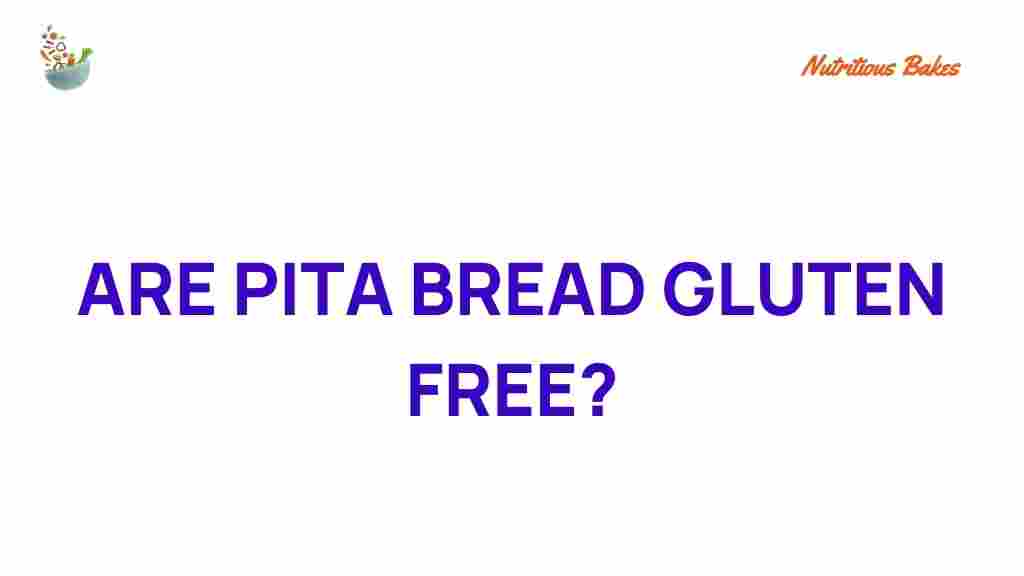Is Pita Bread Gluten-Free? The Surprising Truth Uncovered
Pita bread is a staple in many diets around the world, often enjoyed for its versatility and unique pocket feature. However, for those with gluten sensitivities or celiac disease, the question arises: is pita bread gluten-free? In this article, we will delve deep into the ingredients, nutrition, and health aspects of pita bread while uncovering the surprising truth about its gluten content. We will also explore some delicious gluten-free pita bread recipes and baking tips for those who wish to enjoy this beloved bread without compromising their health.
Understanding Gluten and Its Impact on Health
Gluten is a group of proteins found in wheat and related grains such as barley and rye. For most people, gluten is harmless and can be included as part of a balanced diet. However, for individuals with celiac disease or gluten sensitivity, consuming gluten can lead to serious health issues, including:
- Digestive problems
- Fatigue
- Joint pain
- Skin rashes
As such, it is crucial for those affected to avoid gluten-containing foods. This brings us back to pita bread: is it a safe option for gluten-sensitive individuals?
The Traditional Ingredients of Pita Bread
Traditional pita bread is primarily made from the following ingredients:
- Wheat flour (usually white or whole wheat)
- Water
- Yeast
- Salt
Given that wheat flour is a major ingredient, traditional pita bread is NOT gluten-free. It contains a significant amount of gluten, making it unsuitable for those who must adhere to a gluten-free diet.
The Nutritional Profile of Pita Bread
Understanding the nutrition of pita bread is essential for those who include it in their diet. Here’s a general nutritional breakdown per standard serving (about 60 grams) of traditional pita bread:
- Calories: 165
- Carbohydrates: 33g
- Protein: 6g
- Fat: 1g
- Fiber: 1.5g
While pita bread is a good source of carbohydrates and provides some protein, it lacks certain nutrients found in whole grains. For those looking to maintain a balanced diet, considering whole grain options or gluten-free alternatives is advisable.
Gluten-Free Alternatives to Traditional Pita Bread
For those who cannot consume gluten, the good news is that gluten-free pita bread options are available. These alternatives typically use gluten-free flours such as:
- Rice flour
- Chickpea flour
- Almond flour
- Oat flour
When shopping for gluten-free pita bread, be sure to check the labels for certification, as cross-contamination can occur in facilities that process gluten-containing products. Additionally, many health food stores and supermarkets now carry gluten-free pita options.
Making Gluten-Free Pita Bread at Home
If you’re feeling adventurous in the kitchen, making your own gluten-free pita bread can be a fun and rewarding experience. Here’s a simple recipe to get you started:
Ingredients:
- 1 cup gluten-free all-purpose flour blend
- 1/2 cup warm water
- 1 tsp instant yeast
- 1/2 tsp salt
- 1 tsp olive oil
Instructions:
- In a mixing bowl, combine the gluten-free flour, yeast, and salt.
- Add warm water and olive oil to the dry ingredients, mixing until a soft dough forms.
- Knead the dough for about 5 minutes until smooth.
- Cover the bowl with a damp cloth and let it rise for 30 minutes.
- Preheat your oven to 475°F (245°C).
- Divide the dough into equal portions and roll each piece into a flat circle, about 1/4 inch thick.
- Bake the pita on a baking sheet for about 5-7 minutes, or until they puff up.
- Remove from the oven and let cool before serving.
This homemade gluten-free pita bread is perfect for filling with your favorite ingredients or enjoying with dips like hummus!
Common Troubleshooting Tips for Gluten-Free Baking
Baking gluten-free can be a bit tricky, especially if you’re used to traditional wheat-based recipes. Here are some troubleshooting tips to help you achieve the perfect gluten-free pita:
- Texture: Gluten-free doughs often require more moisture. If your dough feels too dry, add a little more water or oil.
- Puffing: Ensure your oven is preheated sufficiently. A hot oven helps the bread puff up properly.
- Flavor: Experiment with different gluten-free flour blends to find a taste and texture you enjoy.
Additional Gluten-Free Pita Bread Recipes to Try
If you’re interested in exploring more recipes, consider these additional gluten-free pita bread options:
- Chickpea Flour Pita Bread – A protein-rich alternative.
- Cauliflower Pita Bread – A low-carb option that’s packed with nutrients.
- Oat Flour Pita Bread – A hearty option that offers a unique flavor.
Incorporating Pita Bread into a Healthy Diet
Pita bread, whether traditional or gluten-free, can be a nutritious addition to your diet when consumed in moderation. Here are some tips for incorporating it wisely:
- Portion Control: Be mindful of the number of pitas you consume, especially if they are made from high-calorie flours.
- Fill Smart: Fill your pitas with lean proteins, fresh vegetables, and healthy fats to create balanced meals.
- Pair with Nutrient-Dense Foods: Serve pita bread with salads, dips, or stews to enhance your meal’s nutritional value.
Conclusion: The Gluten-Free Reality of Pita Bread
In conclusion, traditional pita bread is not gluten-free, making it unsuitable for those with gluten intolerance or celiac disease. However, with a variety of gluten-free options available in stores and simple recipes to make your own, enjoying pita bread without gluten is entirely possible. Whether you choose to purchase ready-made gluten-free pita or bake your own at home, you can savor this delightful bread while maintaining a healthy and gluten-free diet.
By understanding the ingredients, nutritional profile, and alternatives to traditional pita bread, you can make informed choices that align with your health goals and dietary needs. So go ahead and enjoy pita bread in its gluten-free form, and explore the myriad of recipes that await you!
This article is in the category Ingredients and created by NutritiousBakes Team
